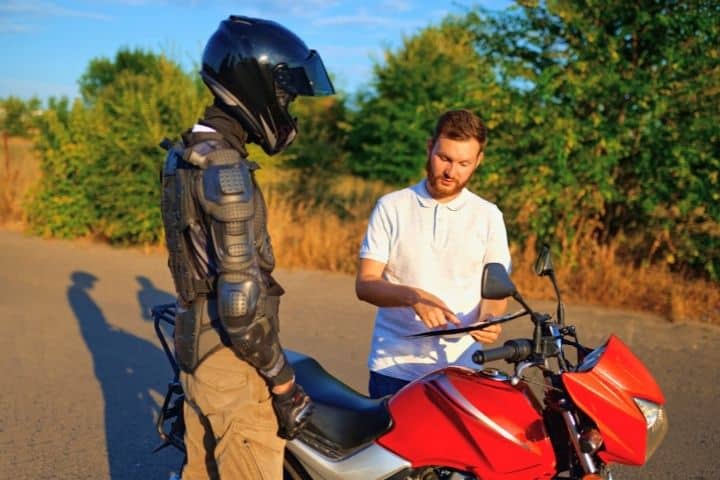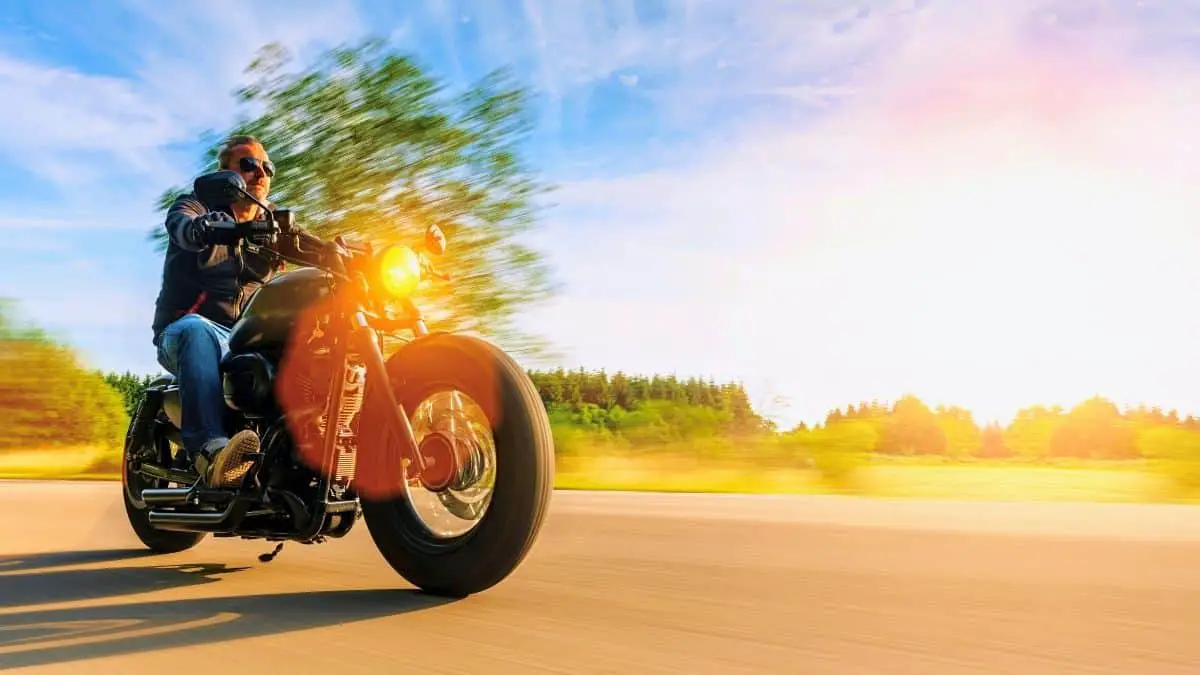Where to Practice Riding a Motorcycle: 6 Best Spots to Not Get Busted
News flash: before you appear for a motorcycle riding test, you need some SERIOUS riding practice.
And whether you prefer marathon practice sessions stretching for hours or short bursts of intense practice, you need to pick the right spot.
But what’s the best place to practice riding a motorcycle before you get a license?
Actually, that depends on where you live. However, in an urban setting, there are always some safe (if hidden) spots that are waiting for you.
Still, finding the right place to do it isn’t so easy. Many property owners avoid the hassle and risk of allowing unlicensed drivers to use their property for practice.
So, here are some suggestions that you can try out.
6 Best Places for Motorcycle Riding Practice

To be honest, riding a motorcycle on a freeway for the first time can be a scary experience.
(Tell me about it!)
But you know what else?
Once you get used to the speed, wind, and vulnerability, it can be an exhilarating feeling.
First of all, before you start practicing, you need to have a motorcycle learner’s permit. The process of obtaining that will vary depending on your state.
Also, make sure that you follow all the necessary rules and regulations of your state while practicing.
The best thing is to enlist for a motorcycle training course from a certified organization. Working with an experienced trainer will help you to understand the nuances of riding better.
If you want to practice by yourself, it’s time to look for a wide-open space that has the minimum number of obstructions. It’s best to practice with an experienced rider who can guide you.
And don’t forget, you need to figure out a way to transfer your motorcycle to and from the practice area. You might be tempted to ride to the practice area. But chances are, your learner’s permit won’t allow it.
So, it’s best not to expose yourself to all forms of legal hassles and fines by trying it.
(You know what they say: “A bad agreement is better than a good lawsuit.”)
One way is to load the motorcycle at the back of your pickup or trailer. Otherwise, you can take the help from your buddy and ride a pillion. In case the spot is just a short distance away, you can even walk your motorcycle there.
One more thing…
Don’t make the mistake of buying your dream machine for practicing. Start with an old and inexpensive bike that won’t break your heart when scratched.

1. Your Own Private Property
Without a doubt, your private property is the best and safest place to practice riding a motorcycle. Not only can you practice in an area free from external interference, but you also won’t be a safety risk to other parties.
That said, not everyone has acres of space to ride freely. But even small spaces are good enough to practice the basic moves starting and stopping and turning at low speed.
⚠️ Don’t try to learn on grass as it doesn’t offer the best traction. You may end up with a slip and a dent in your confidence.
(Did I ever tell you the story of how I fell off a stationary bike once?)
This also allows you to try out all the basic maneuvers without having to worry about driving on public roads. Moreover, there won’t be any legal hassles either.
2. Empty Parking Lots
In most cases, private parking lots are one of the best options for honing your riding skills. There are parking lots that don’t allow cars to enter directly and allow free parking for motorcycle riders. It’s best to use the spots during off-hours when they aren’t so busy
Now hold on…
It won’t be wise to enter any empty parking lot and start practicing. You need to seek out the owner or manager and get their permission. Ideally, you should get permission from them in writing.
In case you are unlucky, any random moron with a dislike for motorcycles might interfere with your practice. Then you can use this paper to shoo them away.
Once you have your permit, check the area for broken glass pieces, oil leaks, or any other item that might affect your practice.

3. Off-road Parks
The biggest advantage of using off-road parks for practice is you can stay out of nosy neighbors and cops. In addition, these zones are free from traffic, obstacles, and other disturbances.
However, your locality might have some guidelines for entering these places with a motorcycle. Make sure to follow them to avoid trouble.
4. Closed School Campuses
Fact is, closed school campuses have always been a favorite spot for young riders to practice their skills with the bike. You get a large and safe environment for practicing all the important drills for safe riding.
Moreover, it’s also a great place for prolonged practice sessions during the weekends. That doesn’t make it legal; but in most cases, you won’t be bothered by cops while practicing in a vacant space.
5. Neighborhood Areas
If your private space isn’t big enough, it’s time to pick out some deserted surface streets that have long straight sections. It’s best if there are no traffic signals to deal with, but you should be careful about the junctions.
If you live in a small town, you may have the privilege of riding around the empty side streets. However, that doesn’t come without the risk of getting ambushed by a cop.
(Frankly, motorcycles are veritable cop magnets.)
As your skill grows, you can expand your practice zone and venture into more challenging situations.

6. Motorcycle Rider Programs
This would be the most obvious option. But as with all things motorbike, conventional choices are usually the last option people are willing to resort to. (I’m only half-joking.)
You may find rider programs being conducted in your neighborhood to train novice riders. These programs are for those who have never ridden before and also for riders with experience. The rider courses from the Motorcycle Safety Foundation (MSF) are a good option.
Apart from hands-on training sessions, the program can also include classroom sessions. The training is usually conducted in public spots like shopping malls.
How to Practice Riding a Motorcycle Without a Motorcycle?
Do you think you need to purchase a motorcycle before learning to ride?
Not really.
In fact, learning the basics of motorcycle riding and creating a firm foundation is a great way to move forward before you make an expensive purchase.
And there are other ways to get your hand on a motorcycle.
There are two easy ways to do it. You can either rent one or borrow one from your rider friend. Obviously, you need to be extra cautious with your friend’s bike so as not to damage it in any way.
Or else you can enroll in a course that allows you to use their equipment. The training courses conducted by MSF allow you to practice with an actual motorcycle. You get around 10 hours of practical training.
You start with the basic practice of clutch and throttle control. In the next stage, you move to the shifting of gears.

In addition, there are a few other things you can do.
- If you haven’t ridden any 2-wheeler before, you can start with a bicycle. While the riding mechanisms are different, there’s one important common aspect that’s vital for any rider – balance. Practicing with a bicycle will help you familiarize yourself with the braking and steering of motorcycles at low speeds.
- Since dirt bikes are easier to control, they are a great option for practicing before moving on to a street bike. Since riding over off-road tracks needs more awareness, dirt bike riding can also enhance your visual skills and attention levels.
How Can I Practice on My Motorcycle?
Practicing the right techniques is not only important during the initial stages, but it also helps to improve your skills even after you get your license.
Here are a few things that you need to focus on while practicing.
- Braking is an important aspect that you need to practice to make full use of your motorcycle’s brakes. Since the braking capacity of a motorcycle is split between the front and rear wheels, you need to practice and get a feel of the brake pressure.
- You won’t believe how many riders lose control of the bike while riding slowly. This is a skill that you need to practice in the initial stages. Learn to manage the weight of the bike effectively while turning at slow speeds.
- Since many motorcycle accidents happen on curvy roads, you need to work on your cornering skills. Seek a two-lane road with a smooth curve and learn to ride in and exit the curve while controlling the throttle.
- Once you have perfected the basic skills, practice emergency maneuvers like emergency swerving and emergency straightening and stopping. The best way to do this is to draw a collision hazard and a single-lane curve with chalk on the practice area. Such an outline will help you to practice more effectively.
Frequently Asked Questions

What are the best places to practice motorcycle riding near me?
The best place to practice motorcycle riding is your own property. Other than that, you can also choose empty parking spots or school compounds during weekends. Ask the veteran riders in your area to help you find the best spots.
Can I ride a motorcycle without a license?
No, you can’t ride a motorcycle without a license. However, you can practice riding it with a learner’s permit. The permit allows you to practice riding under certain conditions. These conditions will vary based on your state or locality.
Is riding a motorcycle in a park illegal?
Generally, riding a motorcycle in a park on a field is considered illegal. Check the legal directives in your locality to get a clear picture.






